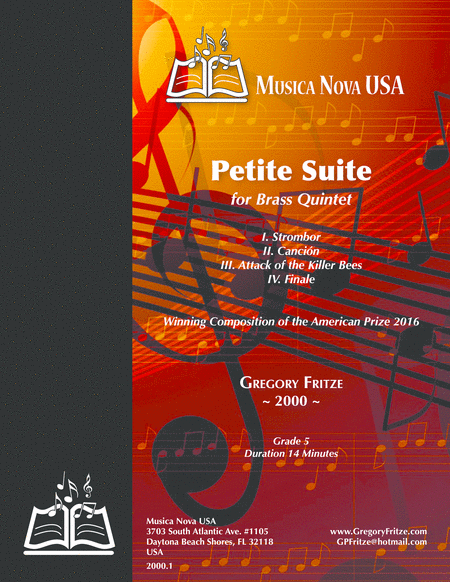Brass Ensemble - Level 3 - Digital Download SKU: A0.917402 Composed by Gregory Fritze. 20th Century,Concert,Contemporary,Standards. Score and parts. 96 pages. Musica Nova USA #4895219. Published by Musica Nova USA (A0.917402). Petite Suite for Brass Quintet is a light-hearted piece for brass quintet in four movements with a duration of fourteen minutes. The four movements follow the basic Classical symphonic form - Allegro, Adagio, Scherzo (Presto) and Finale (Presto). The first movement Strombor has a fanfare at the beginning with a melodic 2nd theme in the French Horn. The second movement is based on a slow cantabile theme. The 3rd movement Attack of the Killer Bees includes a bit of theatre. Throughout the movement there is a buzzing of bees, which are killed at the end when all the players stomp on them. The 4th movement Finale has a feeling of cartoon music, ending with a big finish. Throughout the Suite each of the five instrumentalists is featured. The grade of this piece is level 5 (intermediate) for all instruments.Petite Suite for Brass Quintet was composed in 2000 on a commission by the Strombor Brass Quintet of Valencia, Spain. It was recorded by that group on Allegro Records V-3076-2002. It was also recorded by the Hoodlebug Brass Quintet on Albany Records Troy 1175. It can be heard on youtube at: http://youtu.be/RZFf3W_yZLo. Several ensembles around the world have played it, receiving over 100 performances in recent years. Petite Suite for Brass Quintet was submitted to the American Prize Composition Competition in the chamber music division in 2016. It was the highest awarded brass quintet composition that year, awarded Finalist. Gregory Fritze is a prize-winning composer and Fulbright Scholar, as well as an active performer and conductor. He recently retired from Berklee College of Music where he was Professor and Chair of Composition, serving on the faculty from 1979 to 2016. He has written over ninety compositions for orchestra, band, chamber ensembles and soloists. He has won over fifty composition awards both nationally and internationally, including First Prize in the 1st WASBE (World Association of Symphonic Bands and Ensembles) International Composition Contest 2017, First Prize Winner of Reneé Fisher Composition Prize, First Prize Winner in Concurso Bienal de Composición de Musica para Banda, Ciudad de Santa Cruz de Tenerife (Spain), Menzione dâOnore (highest award given) of the Mario Bernardo Angelo-Comneno International Music Competition by the Accademia Angelica Costantiniana Arti E Scienze (Italy), First Prize in 1991 TUBA International Etude Composition Competition, the IBLA Grand Prize (Italy), several awards from The American Prize, Composition Awards from Standard Awards Panel of American Society of Composers, Authors, and Publishers and many others. His compositions include works published by several publishers in the United States, South America and Europe and have been performed extensively throughout the world. He has been a frequent traveler to Spain since 1993 and has promoted compositions by Spanish composers around the world. He is the only composer who has been commissioned six times by Spanish bands for Certamen competitions, with each band winning first prize. He has thirty-three compositions commercially recorded on Albany Records, MSR Classics, Crystal Records, Mark Records and others. He has been a guest lecturer, conductor and performer at many colleges, universities and music festivals in the United States, Canada, Japan, South America and Europe. He was born in Allentown, Pennsylvania in 1954 and has Composition degrees from the Boston Conservatory and Indiana University. He now resides in Daytona Beach Shores, Florida.
